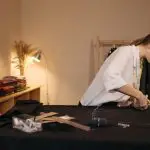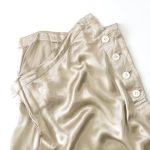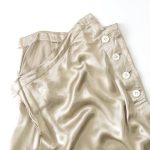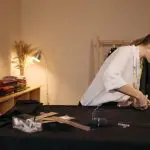Looking to keep your fabric edges neat and tidy? Ever wondered if pinking shears might be the solution? Discover the ins and outs of how pinking shears can help prevent fraying, as well as the best ways to use them effectively.
This concise guide will equip you with the knowledge you need to master the art of preventing fabric fraying with pinking shears.
Explore the benefits and potential drawbacks of using this tool, and gain a deeper understanding of whether pinking shears can replace other methods of fray prevention.
Get ready to take your fabric cutting skills to the next level!
Key Takeaways
- Pinking shears are a quick and easy way to finish fabric edges and prevent fraying.
- They create a decorative zigzag edge that enhances the appearance of the fabric.
- Pinking shears are portable and suitable for small-scale projects or when a serger machine is not available.
- However, they may not be effective for certain fabric types and can leave behind small fabric threads that can still fray.
How Pinking Shears Prevent Fraying
Pinking shears prevent fraying by creating zigzag edges that help to lock the fabric fibers in place, reducing the likelihood of unraveling. When you cut fabric with pinking shears, the zigzagging pattern interrupts the vertical and horizontal threads of the fabric, making it harder for the weave to come undone. This technique is an effective alternative to straight-edge cutting, especially for fabrics prone to fraying. By incorporating pinking shears into your sewing projects, you can ensure that the fabric edges remain neat and tidy, contributing to the overall durability of the finished piece.
In sewing, preventing fraying is crucial for maintaining the integrity of the fabric. Pinking shears offer a simple yet effective solution for fray prevention, making them an essential tool in a seamstress's repertoire. By understanding and mastering this technique, you can elevate the quality of your sewing projects and ensure that your creations stand the test of time.
Whether you're a seasoned seamstress or just starting out, mastering the use of pinking shears can significantly enhance the professional finish of your work.
Choosing the Right Pinking Shears
When selecting pinking shears, consider the type of fabric you'll primarily be working with. The right pinking shears can make a significant difference in your projects. Choose shears that are comfortable to hold and maneuver, as this can impact the precision and ease of cutting. Look for stainless steel blades, as they're durable and maintain sharpness for longer. Additionally, consider the size of the shears. For intricate work, smaller shears may be more suitable, while larger ones are better for cutting through multiple layers of fabric. Proper maintenance is crucial to ensure the longevity of your pinking shears. Clean the blades after each use and store them in a dry place to prevent rusting.
When choosing the right fabric, keep in mind that pinking shears work best on tightly woven fabrics such as cotton, wool, and synthetic materials. They may not be as effective on loosely woven or delicate fabrics. Furthermore, mastering the cutting techniques is essential. Hold the fabric taut and use smooth, even motions to achieve clean and precise edges. With the right pinking shears and proper technique, you can effectively prevent fabric fraying and add a professional touch to your projects.
Tips for Using Pinking Shears Effectively
To get the most out of your pinking shears, ensure that you hold the fabric taut while cutting to achieve clean and precise edges. Here are some essential tips for using pinking shears effectively:
| Tip | Description |
|---|---|
| Maintain Sharp Blades | Regularly sharpen your pinking shears to ensure clean, crisp cuts. |
| Choose the Right Fabric | Pinking shears work best on lightweight to medium-weight fabrics like cotton, linen, and seersucker. |
| Use Proper Cutting Angle | Hold the shears at a 45-degree angle to the fabric edge for optimal fraying prevention and professional-looking finishes. |
| Practice on Scrap Fabric | Before starting on your main project, practice cutting scraps to get a feel for the shears and perfect your technique. |
Can Pinking Shears Replace Other Fray Prevention Methods
Using pinking shears is an effective method for preventing fabric fraying, but they may not entirely replace other fray prevention methods in certain sewing projects. While pinking shears offer unique benefits, there are instances where alternative methods may still be necessary to achieve the best results. Here's why:
- Fabric Type: Pinking shears may work well on lightweight fabrics, but heavier fabrics or those with loose weaves might require additional fray prevention techniques.
- Project Complexity: For intricate designs or projects with multiple layers, using pinking shears alone may not suffice in preventing fraying along all edges.
- Washability: If the fabric needs frequent washing, additional methods such as serging or using fray check may be needed to ensure long-term fray prevention.
- Aesthetic Preferences: In some cases, the look of the finished edge may influence the choice of fray prevention method, and pinking shears mightn't provide the desired aesthetic.
While pinking shears can be a valuable tool in preventing fraying, considering the fabric type, project complexity, washability, and aesthetic preferences will help determine if additional fray prevention methods are needed for a particular sewing project.
Common Misconceptions About Pinking Shears
Despite their effectiveness in preventing fabric fraying, some misconceptions about pinking shears persist among sewing enthusiasts.
One common misconception is that pinking shears can completely replace other fray prevention methods. While pinking shears offer significant benefits in preventing fraying, they aren't a one-size-fits-all solution. They're particularly useful for lightweight to medium-weight fabrics and can be a great addition to your sewing toolkit. However, for heavier fabrics or garments that will undergo frequent washing, using pinking shears alone may not provide sufficient fraying prevention.
Another misconception is that pinking shears are the only alternative to serging or zig-zag stitching. While pinking shears are a popular choice, especially for those who want to avoid machine sewing, there are other alternatives to prevent fabric fraying.
For instance, using fray-check or seam sealants can effectively prevent fraying without altering the fabric's edge appearance. Additionally, using bias binding or Hong Kong seams can offer a polished look while preventing fraying, providing alternatives to pinking shears depending on the project at hand.
Understanding the benefits and limitations of pinking shears, as well as exploring alternative methods, can help you make informed decisions in your sewing projects.
Pros and Cons of Using Pinking Shears
While pinking shears offer effective fraying prevention for lightweight to medium-weight fabrics, they may not be suitable for heavier fabrics or garments that undergo frequent washing.
Here are the pros and cons of using pinking shears:
- Pros:
- Pinking shears create decorative edges, adding a unique and professional finish to sewing projects.
- They're quick and easy to use, making them a convenient option for finishing fabric edges.
- Cons:
- Pinking shears may not be the best choice for fabrics prone to unraveling, as they don't fully prevent fraying.
- They aren't ideal for heavyweight or thick materials, as the zigzag edge may not effectively prevent fraying in such fabrics.
When considering alternatives for finishing fabric edges, keep in mind that there are various sewing techniques and tools available. Serger machines, zigzag stitches, and bias binding are popular alternatives that offer more comprehensive fraying prevention for a wider range of fabric types.
It's essential to evaluate the specific fabric and the intended use of the garment when choosing the most suitable finishing technique.
Frequently Asked Questions
Are There Any Alternatives to Using Pinking Shears for Preventing Fabric Fraying?
For fabric finishing, consider serging the edges to prevent fraying. Seam sealing and fabric glue are also alternatives. These methods provide neat and durable edges, offering effective alternatives to pinking shears for preventing fabric fraying.
Can Pinking Shears Be Used on All Types of Fabric, or Are There Certain Fabrics They Work Better On?
Pinking shears work best on lightweight fabrics like cotton and linen, effectively reducing fraying. When cutting heavier materials, use a rotary cutter for better results. Keep them clean and sharp for optimal performance.
Do Pinking Shears Require Any Special Maintenance or Sharpening to Remain Effective Over Time?
To keep pinking shears effective over time, regular maintenance is key. Sharpening and proper care extend their longevity. For alternative fraying prevention methods, consider serging or using bias tape. Explore fabric edge decoration ideas for added creativity.
Are There Any Specific Sewing Techniques or Patterns That Work Best With Pinking Shears to Prevent Fraying?
When using pinking shears, try sewing techniques like zigzag stitching or using fabric patterns with minimal fraying. Pinking shears are effective at preventing fraying when used on fabric edges, reducing the need for additional seam finishing.
Can Pinking Shears Be Used to Create Decorative Edges on Fabric, or Are They Purely for Preventing Fraying?
Yes, pinking shears can be used to create decorative edges on fabric, not just prevent fraying. They are versatile tools for fabric embellishment, adding a unique touch to your sewing projects.
- Tetron Fabric in Delhi: Where to Find It - June 17, 2025
- Tetron Fabric Vs Other Fabrics: a Comparative Analysis - June 17, 2025
- Creative Uses for Tetron Fabric in Fashion and Home Decor - June 17, 2025







